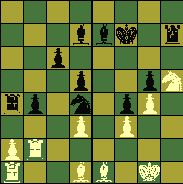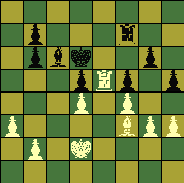
Lecture by UMBC Chess Coach Igor Epshteyn
The art of long term planning and foreseeing winning endgame consist of subsequent constructing favorable pawn structure and pieces on a chessboard more 'compatible' to this pawn chain from your own side. To reach this goal one have to trade the pieces having in mind appropriate types of position. For the positional player the chess game is "generalized trade of pieces" (according to world champion Botvinnik), and the less pieces are on the chessboard, the more it's value depends on the pawn structure. That means that player have to consider and evaluate the connection between pieces and structure not only in every moment of the game , but also have to know the ways to convert it to favorable "static" structure in relation to the pieces available.
It also supposes the tools and abilities to force the trade of pieces that complicate or hinter the way to result endgame.The main controversy of such kind of positions for the defending side is, that almost till the final endgame, the position does not looks hopeless for them, but reasonable requirement for the pieces activity accelerates it's trade and makes closer hopeless endgame. It is exactly endgame - the final stage of the game - where the 'bad' pieces looks most misarable because:
Pawn chain is the main enemy of the bishops of determined color (first principle of Capablanca). At the beginning of the game pawn chain have to be elastic(flexible) in order to reserve an ability to reconstruct it in conjunction to future exchanges of pieces. The 1-st principle says that one have to place the pawns to the squares of of opposite color to the own bishop. But the question is, what if the rival bishop is the same color, and own pawn chain will reserve as the lines for the own bishop as the 'holes' for enemy. Another problem have to be evaluated is what is more important - unbroken pawn chain, sufficiently restricting space for enemy pieces activity, or open files for own rooks. With broken chain the pawns, blocked on the squares of rival bishop color will bring troubles in endgame. There should not be any shadow of dogma in understanding of those questions. Main difference in evaluation lies:
The represented games allows to review the whole topic. In 1-st game the world champion demonstrated how the pawn chain conversion can be used to reevaluate the importance of the same color bishops. This masterpiece is story-tale about 'cinderella' - imaginatively 'bad' bishop on b7 - became at last 'good', and imaginatively 'good'(on q2) became 'bad' in endgame. Final rook sacrifice set an artistic impression. The 2-nd game of the top-level grandmasters is very instructive as of their play as of their positional mistakes. Homework contains the questions to the key positions of the games.
1. d4 Nf6
2. c4 e6
3. Nf3 b6
4. g3 Bb7
5. Bg2 Be7
6. 0-0 0-0
7. Nc3 d5
8. Ne5 Qc8
9. cxd5 Nxd5
10. Nxd5 exd5
11. Qb3 Qe6
12. Nd3 Rd8
13. Be3 c6
14. Rfd1 Nd7
15. Rac1 Nf6
16. Rc2 Ne4
17. Rdc1 Rac8
18. Nf4 Qd7
19. Qa4 a5
20. Qb3 b5
21. Qd3 g5
22. Nh5 f5
23. f3 Nd6
24. Bf2 Rf8
25. b3 Rf7
26. h3 Qe6
27. g4 Qg6
28. Bg3 f4
29. Bf2 Qxd3
30. exd3 b4
31. Re1 Rc7
32. Re5 Nb5
33. Kh2 Bc8
34. h4 h6
35. hxg5 hxg5
36. Kg1 Bd7
37. Rce2 Kf8
38. Rc2 Ra7
39. Bf1 a4
40. bxa4 Rxa4
41. Rb2 Nc3
42. Re1 Rh7
43. Ra1 Kf7
44. Be1 Nb5
45. Be2 Nxd4
46. Bd1 c5
47. Bxa4 Nxf3
48. Kf2 Bxg4
49. Bd1 Ne5
50. Bxg4 Nxg4
51. Kg1 Rxh5
52. Rg2 Bf6
0-1
1. d4 d6
2. c4 e5
3. Nf3 e4
4. Ng5 f5
5. Nc3 Be7
6. Nh3 c6
7. g3 Nf6
8. Bg2 0-0
9. 0-0 Na6
10. f3 exf3
11. exf3 d5
12. cxd5 Nxd5
13. Nf4 Nac7
14. Qb3 Bf6
15. Rd1 Rf7
16. Ncxd5 Nxd5
17. Nxd5 Qxd5
18. Qxd5 cxd5
19. Bf4 Be6
20. Be5 Bd8
21. Rac1 Bb6
22. f4 Rff8
23. Bc7 Rfc8
24. Bxb6 axb6
25. a3 Kf7
26. Bf1 Ke7
27. Rxc8 Rxc8
28. Bd3 g6
29. Kf2 Kd6
30. h3 Bd7
31. Rg1 h5
32. Ke3 Re8
33. Kd2 Rh8
34. Be2 Rf8
35. Rc1 Rh8
36. Rc3 Bc6
37. Rb3 Kc7
38. Bf3 Rf8
39. Re3 Kd6
40. Re5 Rf7
41. b3 b5
42. Kc3 Rf8
43. Kb4 Ra8
44. Be2 Bd7
45. Re3 Ra7
46. h4 Ra8
47. Bxb5 Bxb5
48. Kxb5 Rxa3
49. Kb6 Ra2
50. Rd3 Rb2
51. Kxb7 Rc2
52. Kb6 Rc8
53. b4 Rb8
54. Ka5 Ra8
55. Kb5 Rb8
56. Ka4 Ra8
57. Kb3 Ra1
58. Rc3 Rd1
59. b5 Rxd4
60. b6
1-0

Carefully analyze a decisive continuation for Black.

Questions: